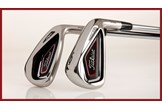NEW GEAR: Titleist launch new AP1 Irons
Published: Last updated:
You’ve probably been told on more than one occasion that Titleist are a serious golfers’ brand, that they only make equipment for the better players amongst us. After spending some time hitting their new 716 irons we’d urge you to reconsider.
You’ve probably come across the AP1 and AP2 names before – they were first introduced in 2008 and the AP2s have been a firm favourite with their Tour players ever since. Well now both models have been updated and amended and their ready for action in the hands of you the club golfer.
It’s not often Titleist makes sweeping claims and promises of more distance, ball speed and forgiveness, they’re usually much more restrained. But they are doing just that and billing the new AP1s as their longest, most forgiving irons ever.
That’s quite a statement considering their rich history, major wins and the amount of Tour players relying on their clubs to make a living. This is how they’ve done it.
Extreme Tungsten Weighting
Tungsten is a really expensive metal to work with, but it’s much denser than the typical steel that’s used in club heads. Lots more weight can be focused in a specific area of the clubhead to improve its MOI performance or position the centre of gravity location precisely. On average 43g of tungsten (50% more than 714) is used in each AP1 iron (except the short irons) creating a really forgiving, high MOI design that’s very easy to hit. Admittedly other manufacturers use tungsten, but Titleist claim they use much more than their competitors, who typically insert anything between 2 – 12g per head.

Undercut Cavity and Unsupported Face
If you’ve not heard about speed slots and compression channels before we can only assume you’ve been living in a cave on some far flung off-grid desert island for the last five years. Titleist’s spin is to strengthen the faces of the AP1s, which means Titleist technicians have been able to remove the bulk of weight that supports the chassis behind the club face. By removing this bulk it naturally allows the face to flex at impact which transfers more energy back to the ball, which ultimately means maximised distance from your current club speed. Clever stuff and there’s no external slots to look at either.
Familiar chassis with bevelled top edge
Titleist are really confident their head shapes are what golfers want. They constantly consult with both their tour staff and club golfers over what they do and don’t like about their products and, you’ve guessed it, head shape always tops their list of things not to change.
What Titleist have done on this incarnation is to bevel the top-edge beautifully, taking away the chunkiness of an all out game improvement design and meaning the AP1 now has a huge target audience.

Smaller head but better MOI
If you took the best game improvement iron you could find in 2015 and made the head smaller so it looked more appealing, but at the same time improved its MOI performance so its more forgiving how much would you want a set? Well Titleist claim that’s exactly what the AP1 does. Their blade length compared to traditional game improvement irons is shorter, so visually the head looks a little smaller but because they use so much tungsten the MOI performance is actually higher. Which hats off is really impressive.
Lightweight XP90 Shaft
Lightweight steel shafts have developed a strangle hold on the game improvement iron sector as they help golfers increase head speed without changing their swing. The XP90 is a leading lightweight shaft, but its worth remembering if you invest in a set of Titleist and want to max out your potential proper custom fitting is definitely the best way forward.
Expect to see the new AP1’s in good golf stores from today from £93 (s), £107 (g) per iron. For further information visit www.titleist.co.uk

